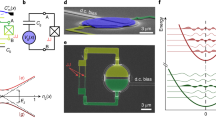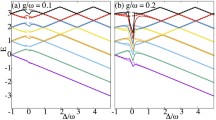Abstract
We have studied the squeezing properties of a Nanomechanical resonator coupled to a qubit and driven by two resonant lasers of unequal intensities. The squeezing can be transferred from X quadrature to P quadrature by selecting the qubit states. Squeezing can be increased by increasing the parameter \(\eta =g/\omega _0\), where g is the resonator-qubit coupling strength and \(\omega _0\) is the resonator frequency. The strong laser does not play any role on squeezing. We have also shown the anti bunching effect of the phonon field by plotting the second order correlation function.







Similar content being viewed by others
Data Availibility Statement
This manuscript has associated data in a data repository. [Authors’ comment: All data includede in this manuscript are availaible upon request by contacting with the corresponding author.]
References
V.V. Dodonov, Nonclassical’ states in quantum optics: asqueezed’ review of the first 75 years. J. Opt. B: Quantum Semiclass. Opt. 4(1), R1 (2002)
P. Verlot, A. Tavernarakis, T. Briant, P.-F. Cohadon, A. Heidmann, Backaction amplification and quantum limits in optomechanical measurements. Phys. Rev. Lett. 104(13), 133602 (2010)
V. Peano, H.G.L. Schwefel, Ch. Marquardt, F. Marquardt, Intracavity squeezing can enhance quantum-limited optomechanical position detection through deamplification. Phys. Rev. Lett. 115(24), 243603 (2015)
J. Aasi, J. Abadie, B.P. Abbott, R. Abbott, T.D. Abbott, M.R. Abernathy, C. Adams, T. Adams, P. Addesso, R.X. Adhikari et al., Enhanced sensitivity of the ligo gravitational wave detector by using squeezed states of light. Nat. Photonics 7(8), 613–619 (2013)
L. Diósi, Models for universal reduction of macroscopic quantum fluctuations. Phys. Rev. A 40(3), 1165 (1989)
D.F. Walls, Squeezed states of light. Nature 306(5939), 141–146 (1983)
R. Slusher, L.W. Hollberg, B. Yurke, J.C. Mertz, J.F. Valley, Observation of squeezed states generated by four-wave mixing in an optical cavity. Phys. Rev. Lett. 55(22), 2409 (1985)
D.M. Meekhof, C. Monroe, B.E. King, W.M. Itano, D.J. Wineland, Generation of nonclassical motional states of a trapped atom. Phys. Rev. Lett. 76(11), 1796 (1996)
D. Wigger, S. Lüker, V.M. Axt, D.E. Reiter, T. Kuhn. Squeezed phonon wave packet generation by optical manipulation of a quantum dot, in Photonics, vol. 2, Tansu, N. (ed.) (Multidisciplinary Digital Publishing Institute, 2015) pp. 214–227.
E.E. Wollman, C.U. Lei, A.J. Weinstein, J. Suh, A. Kronwald, F. Marquardt, A.A. Clerk, K.C. Schwab, Quantum squeezing of motion in a mechanical resonator. Science 349(6251), 952–955 (2015)
A. Pontin, M. Bonaldi, A. Borrielli, F.S. Cataliotti, F. Marino, G.A. Prodi, E. Serra, Squeezing a thermal mechanical oscillator by stabilized parametric effect on the optical spring. Phys. Rev. Lett. 112(2), 023601 (2014)
G.S. Agarwal, S. Huang, Strong mechanical squeezing and its detection. Phys. Rev. A 93(4), 043844 (2016)
F. Lecocq, J.B. Clark, R.W. Simmonds, J. Aumentado, J.D. Teufel, Quantum nondemolition measurement of a nonclassical state of a massive object. Phys. Rev. X 5(4), 041037 (2015)
M. Das, J.K. Verma, P.K. Pathak, Generation of the superposition of mesoscopic states of a nanomechanical resonator by a single two-level system. Phys. Rev. A 96(3), 033837 (2017)
S. Mandal, Squeezing, higher-order squeezing, photon-bunching and photon-antibunching in a quadratic hamiltonian. Mod. Phys. Lett. B 16(25), 963–973 (2002)
S. Mandal, On the quantization problem of a driven harmonic oscillator with time dependent mass and frequency. Mod. Phys. Lett. B 17(18), 983–990 (2003)
R.J. Glauber, The quantum theory of optical coherence. Phys. Rev. 130(6), 2529 (1963)
C. Gerry, P. Knight, P.L. Knight, Introductory quantum optics (Cambridge University Press, 2005)
H.J. Carmichael, Photon antibunching and squeezing for a single atom in a resonant cavity. Phys. Rev. Lett. 55(25), 2790 (1985)
X.T. Zou, L. Mandel, Photon-antibunching and sub-poissonian photon statistics. Phys. Rev. A 41(1), 475 (1990)
W.A.T. Nogueira, S.P. Walborn, S. Pádua, C.H. Monken, Experimental observation of spatial antibunching of photons. Phys. Rev. Lett. 86(18), 4009 (2001)
Acknowledgements
This research work was financially supported by DST, India (File No. DST/ICPS/QuST/Theme-1/2019/4).
Author information
Authors and Affiliations
Corresponding author
Appendix
Appendix
1.1 Appendix A
In general the squeezing operator is given by,
This is an unitary evolution operator with \(\xi =re^{i\theta }\), r is the squeezing parameter varies from \(-\infty \) to \(+\infty \) and \(\theta \) varies from 0 to \(2\pi \). We see that the squeezing operator corresponds to the Hamiltonian \(H \propto ({\hat{a}}^2+{{\hat{a}}^\dag 2}) \) which contains non linear terms in \(a,a^{\dag }\). This non-linearity will create some dynamical link between \({\hat{a}}\) and \( {\hat{a}}^\dag \) as shown in our paper [14] where we see that the time evolution of \({\hat{a}}(t)\) depends on \({\hat{a}}^\dag (t)\) and vice versa. This type of dynamics is necessary to create squeezed states.
1.2 Appendix B
The Hamiltonian of the system in rotating frame is given by,
where \(\omega ,a,(a^\dag ),\Omega _1,(\Omega _2),g,\sigma _-(\sigma _+)\) are frequency of NMR mode, annihilation (creation) operator for phonon field, coupling constants for qubit with first (second) external field, coupling constant for qubit with NMR mode, lowering (raising) operator for qubit, respectively. In order to get a clear picture of the interaction of the Hamiltonian (1), we perform a time-independent unitary transformation. \( {\tilde{H}}= e^sHe^{-s}\), where \(s=\eta |e\rangle \langle e|(a^\dag -a)\) and \(\eta =g/\omega \). The term \(e^s=e^{\eta (a^\dag -a)|e\rangle \langle e|} \), is the rotation operator for the qubit whereas it will act as the displacement operator in phonon mode a.
The above Hamiltonian takes the form,
For most practical cases \(\eta \sim 10^{-3} \), which is very small. That’s why we expand the above Hamiltonian up to 2nd order in \(\eta \) and then rearranging the terms,
We further rewrite the above Hamiltonian in the interaction picture in which the interaction with the stronger field has been diagonalized. In this picture, the state of the system \({\tilde{\psi }}\) and the Hamiltonian \({\tilde{H}}\) are transformed to,
Where \(h=\Omega _1(\sigma _++\sigma _-)\). The qubit spin operators \(\sigma _\pm \) transform as,
As we consider that the qubit is driven strongly such that \(\Omega _1\) is very large(\(\Omega _1\gg g,\Omega _2 ,\omega ,\Gamma \)), and therefore we can neglect the highly oscillating terms i.e. \(sin(2\Omega _1t)\approx 0\)
as \(cos(\Omega _1 t)\approx 0\). Similarly, \(\sigma _-\rightarrow \sigma _-cos^2\Omega _1t+\sigma _+sin^2\Omega _1t\approx \frac{\sigma _++\sigma _-}{2}\). Thus \(\sigma _++\sigma _- \rightarrow \sigma _++\sigma _-\) and \(\sigma _+-\sigma _- \rightarrow 0\). Under this approximation, the effective Hamiltonian becomes,
After simplification the above Hamiltonian becomes,
Rights and permissions
Springer Nature or its licensor holds exclusive rights to this article under a publishing agreement with the author(s) or other rightsholder(s); author self-archiving of the accepted manuscript version of this article is solely governed by the terms of such publishing agreement and applicable law.
About this article
Cite this article
Bayen, D.K., Das, M. Non-classical properties of a mechanical resonator coupled to a qubit. Eur. Phys. J. Plus 137, 984 (2022). https://doi.org/10.1140/epjp/s13360-022-03162-z
Received:
Accepted:
Published:
DOI: https://doi.org/10.1140/epjp/s13360-022-03162-z




